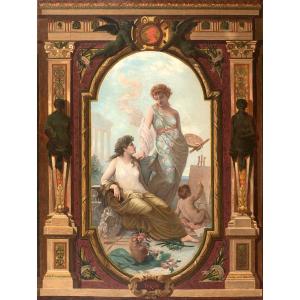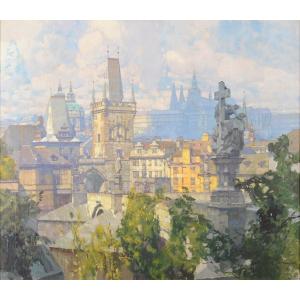(Toulon, 1707 - Paris, 1771)
Portrait of a woman as Saint Cecilia
Oil on canvas
H. 76 cm; W. 62 cm
Coming from the prolific van Loo dynasty established in France following Jacob van Loo around 1630/40, Louis-Michel was a painter, like the two generations which separated him from the Dutch great-grandfather. The young man begins his apprenticeship with his family, alongside his father, Jean-Baptiste, while they live in Italy, Rome and Turin. At 18, he won the prize of the Royal Academy of Painting and Sculpture, before returning to Rome with his uncle, Carle, until 1732. He then moved to Madrid where he spent twenty years. as the official court painter of Philippe V. In 1753, van Loo returned to France and joined the court, where he produced many portraits. Louis XV and the royal family will be regularly represented, like the thinking or fortunate heads of this century of splendor. His portraits, which one recognizes at first glance, are often distinguished by rosy and powdery faces, slightly chubby, where the main features of the physiognomies are highlighted. These masks with well-embodied sweetness are for many made in backdrops of interior decorations with rich ornaments and especially with colorful fabrics.
Our portrait, certainly produced shortly before the painter's death in 1771, is in the purest tradition of the effigies of the French court made by the painter. In the 18th century, the representation of the patron saint of musicians was extremely rare. This figure of a woman usually dressed as the Virgin is represented with her hands on the keyboard of an organ. These compositions, which are often found in the 16th and 17th centuries throughout Europe, are no longer up to date during the Enlightenment. However, this work, dated around 1770, draws very clear inspiration from the representations of Saint Cecilia that van Loo was able to see in Italy. As for the young woman who is represented, it is very clearly a portrait, and not a religious effigy. Actress, opera singer or just interested in music? The pose and court attire, the gaze in the direction of the spectator and the manner of holding the score illustrate this period from portraiture to the transition of the reigns of Louis XV and his grandson.

























 Le Magazine de PROANTIC
Le Magazine de PROANTIC TRÉSORS Magazine
TRÉSORS Magazine Rivista Artiquariato
Rivista Artiquariato
